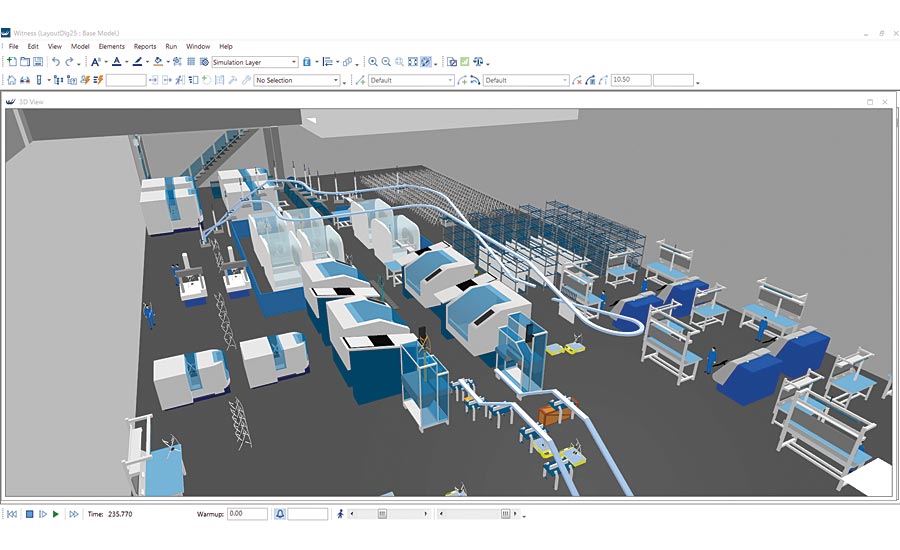Getting Started with Industry 4.0
The challenge for many businesses is knowing where to begin.

A 2D digital model of a facility within WITNESS software. Source: Lanner

A 3D wireframe model of a facility within WITNESS software. Source: Lanner

A 3D digital model of a facility within WITNESS software. Source: Lanner

A 3D digital model of a manufacturing plant. Source: Lanner

The Hayward Tyler factory of the future. Source: Lanner





The manufacturing sector is currently saturated with Industry 4.0 (aka the Industrial Internet of Things or IIoT) hype and jargon. This is no surprise given the evidence showing that the connectivity of systems and exploitation of data can add significant value to modern manufacturing processes and supply chains. Boston Consulting Group anticipates that by 2020, the digitization of manufacturing processes, connected supply chains and new business models will add $1.3trillion to global economies.
Businesses that invest correctly and harness the enhanced capabilities offered from digitizing their industrial assets will benefit from greater insight into their business operations, increased agility at lower cost and the potential to respond to individual customer requirements in ways that will revolutionize today’s business models. It is therefore no surprise that digitization strategies are dominating board discussions.
There is no shortage of potential in the far reaching concept loosely defined as Industry 4.0. Smart factories featuring autonomous cyber-physical systems and additive manufacturing will identify individual products as they are processed allowing mass customization and the ability to keep customers informed of lead times and delivery schedules. Intelligent fault identification systems, augmented operator guidance and predictive maintenance will reduce quality defect levels while increasing delivery responsiveness.
Knowing Where to Begin
The challenge for many businesses is knowing where to begin. There are many digital technologies available and even more technology vendors pushing a ‘digital leap of faith’ to make significant Industry 4.0 technology investments with merely the promise that the business value will eventually materialize. For many, understanding which investments should be made within their limited resources, in what sequence these investments are best made, and what realistic returns should be expected are challenges that have left many confused.
It’s clear that standing still and waiting for others to lead the way is not an option given that the competitive risks are so high. Across many industries there are examples of new competitors using smart digital technologies to create innovative, customized products which can be delivered more responsively, cost competitively and to higher quality levels. They are doing so through the deployment of new business and operating models which deliberately change the rules of the market to make their competitors less relevant.
Take for example NVidia, well known for high-end gaming and graphics technology. A few years ago, they established themselves in the automotive industry by providing multimedia interfaces and have since gone on to become a core software platform to support autonomous vehicles. Likewise, Under Armour who broke into the sportswear market with their innovative base layers have since expanded into performance tracking, fitness scales and health monitoring devices as they attempt to position themselves as a platform for measuring well-being. Both companies have pro-actively driven large disruption across their manufacturing facilities and supply chains.
Establishing a Base Camp for your Digital Journey through Predictive Modelling
Leading firms in automotive and manufacturing have deployed predictive simulation models to ask and answer major business process change and new technology investment questions for decades. Unlike many other predictive analytics technologies, predictive simulation has been deployed at scale for many years by these firms and has been embedded as business as usual by many for major capital expenditure decisions. Many less structured firms have avoided using such technologies, preferring to rely on experience and intuition; however, time is fast running out for gut-feel management as operations become more complex, connected and agile.
The implementation of Industry 4.0 naturally generates similar opportunities, risks and business questions to the implementation of new technologies in the past. It’s therefore reassuring to know that well-proven software technology is available that can provide a highly visual predictive model of your business and gauge the impact of different implementation options. By capturing your business logic, rules, assets and processes within a digital model, businesses can access a visually rich and statistically accurate method for testing their investment options and future changes across their organization.
These models are able to simplify complex operational behaviors. The future-state data they provide is ideal for empowering clearer planning decisions, building comprehensive cost justifications and managing many of the risks associated with change. For these reasons alone predictive simulation offers an ideal starting point when considering investments in digital transformation through the application of Industry 4.0 technologies.
For many, a real value-add from a predictive simulation model is its ability to understand the complex dynamics of the current-state business before moving towards full digitization. Capturing processes and data in a visual, dynamic model secures the cross-functional engagement needed to establish effective strategic alternative investment options. As investments in new Industry 4.0 technologies are made, the data driving such models can be refined via operational data sources such as those provided by modern equipment and real-time data sensors. As the level of digitization progresses the model can hook into increasingly accurate and timely data flows providing both enhanced predictions based on business plans but also a real-time ‘digital twin’ representation of current operations and schedules.
A predictive digital twin is capable of showing the current state of the business across different media, offering management a view of the business that surpasses traditional reports. Options include 3D visualization, augmented and virtual reality and dashboards that not only show key performance indicators, but allow individual points of interest to be examined in detail, drilling down into deep business data. Such dashboards can use predictive data to alert when and where potential future problems may occur. Using the right Industry 4.0 technologies, they can even provide the controls necessary to invoke remedial action. This form of dashboard will increasingly become the digital control panel or ‘predictive management cockpit’ for tomorrow’s operations managers.
Hayward Tyler, a designer and manufacturer of mission critical pumps and motors, used this technology to create a digital twin of their manufacturing facility. This award winning approach demonstrated how the factory would operate before it was even constructed and validated the development of a new carrier transportation, designed specifically to improve throughput throughout the facility. The predictive simulation technology is currently being developed to improve production scheduling capability to keep customers informed of when they can expect to receive their orders.
Evolution versus Revolution
The term Industry 4.0 is derived from the common view that the digital change driving industrial systems, processes and products to become increasingly connected heralds the fourth Industrial Revolution. The big question facing many existing companies is how to balance their ambition to best exploit smart manufacturing technologies to enable new, more competitive operating models alongside the commercial, technological and people constraints that exist in their individual reality.
Many will feel that an incremental approach to digitizing their business is the only viable way forward and certainly the most affordable without widespread investment. In this instance, rather than investing with the hope of discovering an opportunity to add value, those evolving their business should look to use smart digital technologies to address existing challenges and opportunities, related to customer experience, operational performance, product quality and cost. This more traditional approach is likely to be the route many firms take in the short term, while keeping a close watch on competitor strategies. Each step on this evolutionary path will be carefully paced to ensure that actions taken are well-planned and deliver results that will instill confidence to take the next step towards becoming a more digitally intelligent business.
Irrespective of the pathway taken, innovation brings change and change brings risk. Smart manufacturing companies should find comfort knowing that above the shop floor, predictive technologies are available for them to deliver the certainty they need to future-proof their business journey towards Industry 4.0.
Looking for a reprint of this article?
From high-res PDFs to custom plaques, order your copy today!










